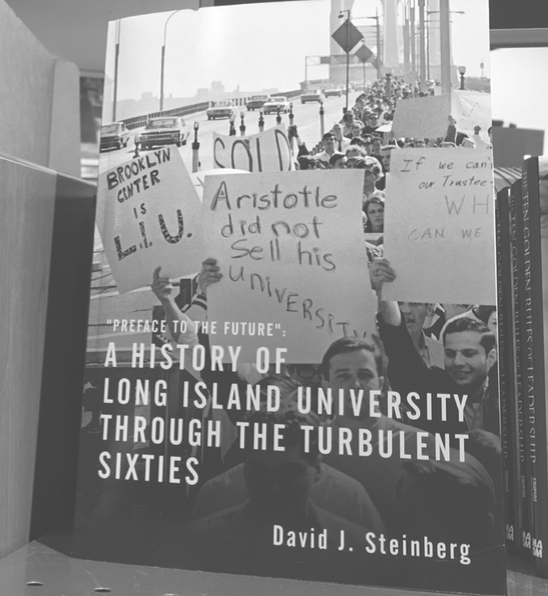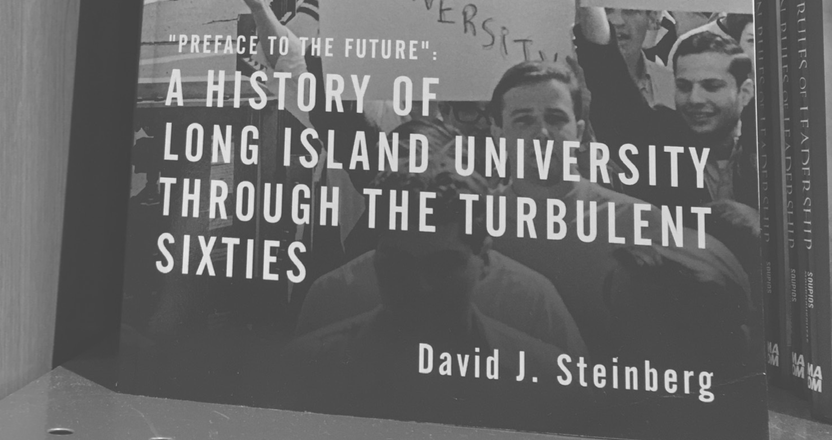By Maxime Devillaz
Alumni Contributor
LIU President emeritus David J. Steinberg chronicles the complex past of one of Long Island’s most important institutions, its first chartered university, in his newly released book, “Preface to the Future: A History of Long Island University through the Turbulent Sixties.”
A revived historian, Steinberg embeds that story in the 20th century evolution of Long Island itself: a fascinatingly diverse place with its mix of urban, suburban and ex-urban, yet, in his words, “struggling in finding itself as something other than a colonial dependency of Manhattan.” Steinberg depicts the tumultuous ‘60s when college campuses were plague spots for student uproar nationwide. “There were two quagmires: the rice paddies of the Mekong delta and the college campuses across America,” Steinberg writes.
President Lyndon Johnson’s tug-of-war with communism in Vietnam led to intergenerational disputes at home. As a result, Steinberg writes, “traditional institutions and mores were jettisoned.” Meanwhile, private sector colleges were close to bankruptcy following the city and state funding of CUNY and SUNY. “Legislators asked why they should funnel federal dollars to institutions that encouraged sexual license, a drug culture, and an open rebellion against the national priority of the Vietnam War?” Steinberg explains.

Steinberg’s book is also available for purchase at the campus bookstore.
While most colleges suffered, LIU also found itself in internal strife. The university struggled to unite its three separate campuses in Brooklyn and Long Island’s Nassau and Suffolk counties under one administrative umbrella. “During this decade, students marched and demonstrated; faculty members protested and then militantly unionized; and trustees privately and publically fought with each other,” Steinberg writes, adding that the university frequented the front page of The New York Times— never in a bright light.
The president emeritus deep-dives into this political tussle, and the preeminent characters of the saga. There was William Zeckendorf, a philanthropic spirit in the late ‘40s, who made LIU an institution that flourished. With its Brooklyn swagger, it marched towards national recognition.
Thereupon, a sudden American Airlines crash turned the tide in 1962, as then-university leader—charismatic, four-star Admiral Richard Conolly—was onboard the plane. Over the next decade LIU was led by five chancellors, one of whom was effectively red after just 78 days.
Not to mention the joker in the deck: Gordon Hoxie—the congenial self-promoter, or as Steinberg puts it, “a dreamer who graduated from a state teachers college with limitless ambitions.” Hoxie became a centrality in the so-called “Preface to the Future”—a ten-year development plan published in 1967 with a tone of optimism. It was to be studied cautiously and distinctly followed for the university to get back on the saddle. The reality, however, looked more like riding on a unicorn. “By the time it was printed, it was already dismissed as a gigantic fantasy; an embarrassing monument to his ambition,” Steinberg writes. “Virtually no part of it came to pass. To read it now, decades after publication, is an elegant journey into a lost world.”
The book chronicles key moments building up to the tumultuous decade, and some of its aftermath. It mentions the 1920 founding by a group of Brooklyn civic and business leaders; an Olympic Game invitation to the LIU Blackbirds men’s basketball team in 1939; and the sale of the Suffolk County campus to the State University of New York in 1970.
Steinberg, who served as LIU president for almost 30 years, is upfront with his bias, and thus deliberately cautious in analyzing the overwhelming unkempt records from that time. The text, easily to be made dry with such numeric and old-school lingo, rather turned into eager storytelling—at some points surprisingly witty— and room for readers to interpret the nuances of characters and events for themselves.
As Steinberg writes,, there are some healthy take-homes for the LIU family, but also for those interested in the evolvement of Long Island, or leadership. “Is the tale of LIU a modern day morality play, posing questions such as how do groups within any society or institution resolve conflict, behavior or decision-making?” Steinberg writes. “What is the responsibility of an individual to lead, fail to lead, or simply waffle?”
In truth, LIU has, in the years that followed, learned and managed to restore its ultimate calling: graduating thousands of students. This calling, the author argues, is devoted to “educating men and women drawn from lower middle-class, self-employed, and wage-earning groups. They are first-generation college-goers and often first-generation Americans.” He adds, “LIU, after almost a century, still exists as a private institution devoted to speeding them on their way.”
The paperback is published by CreateSpace, and is available for $24.95 at various booksellers, including the campus bookstore.




Be First to Comment